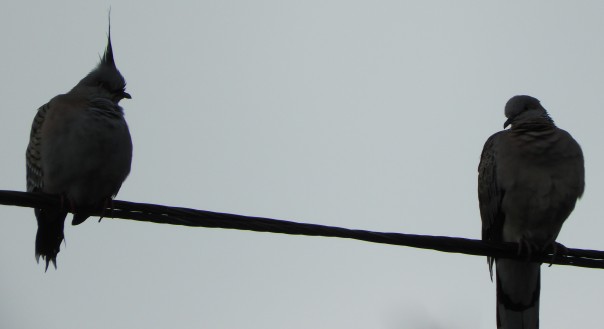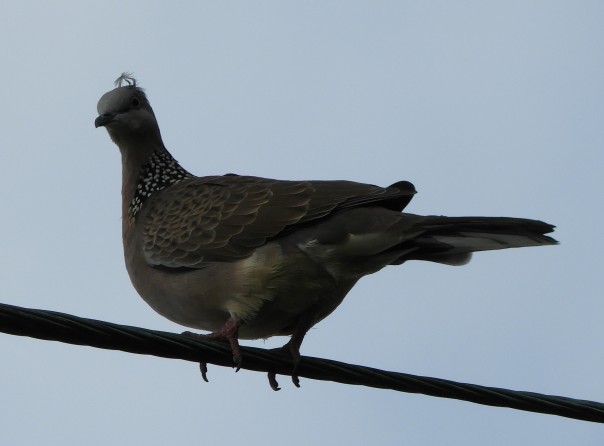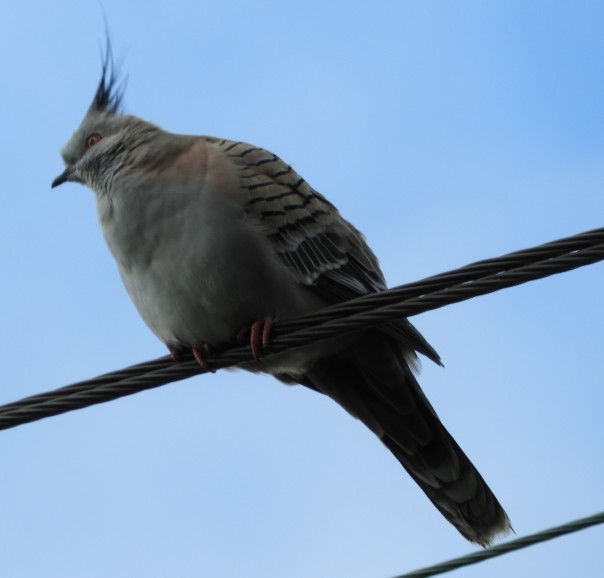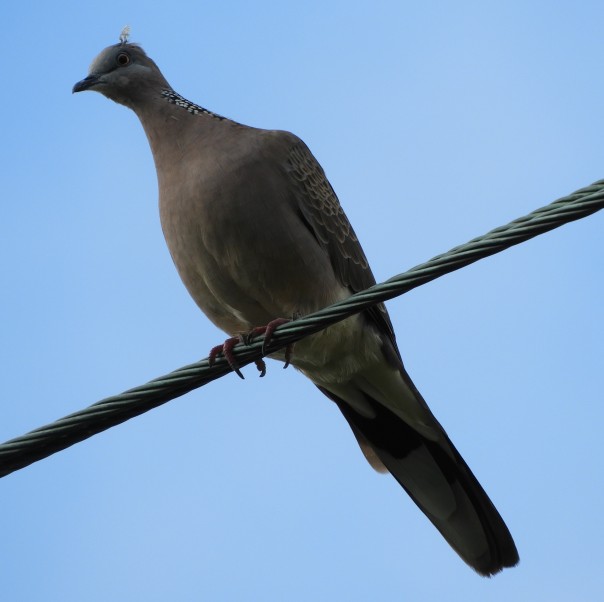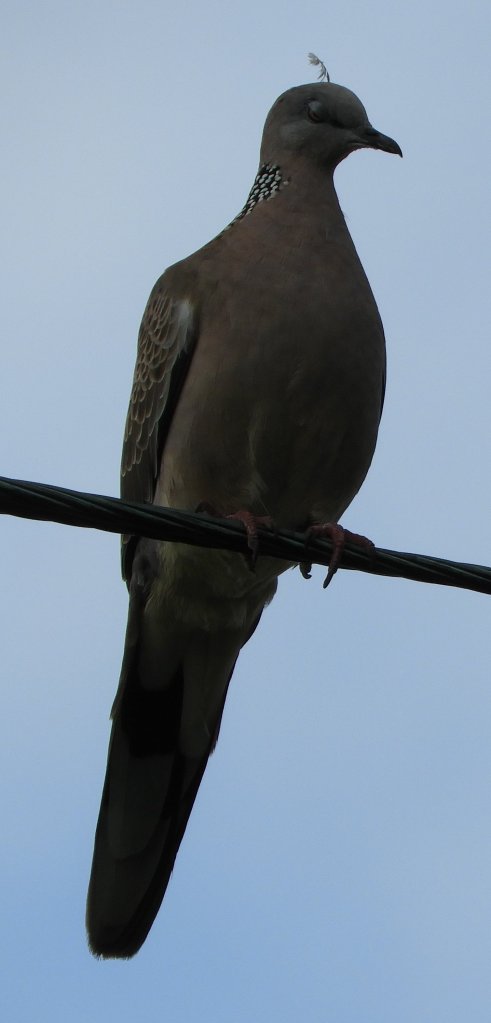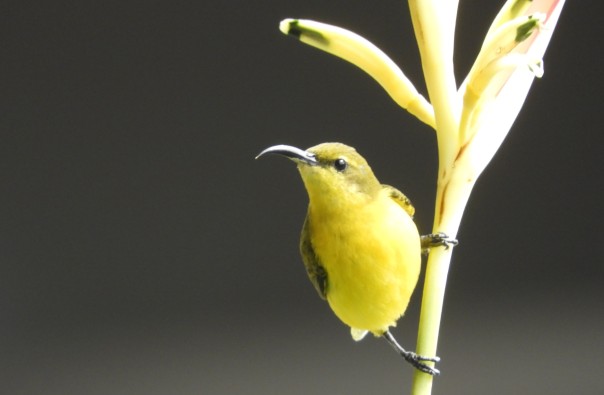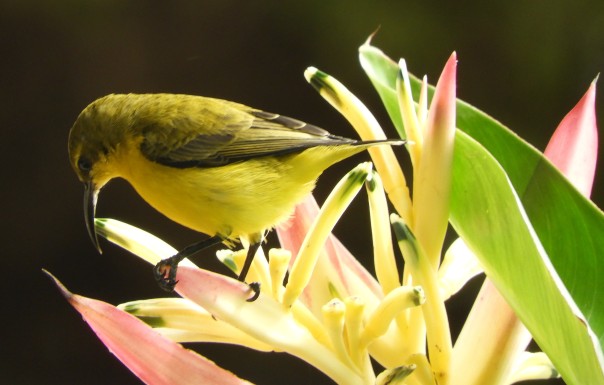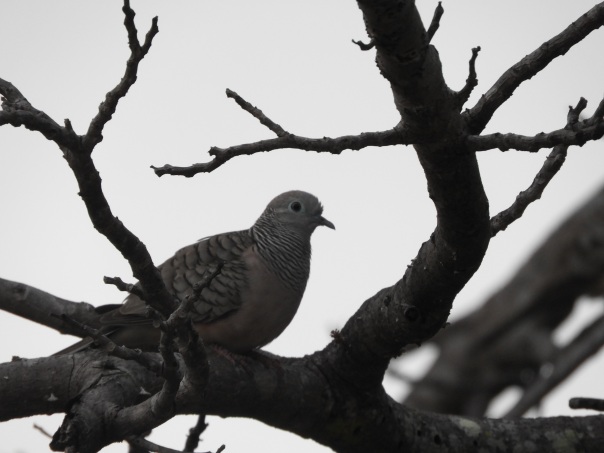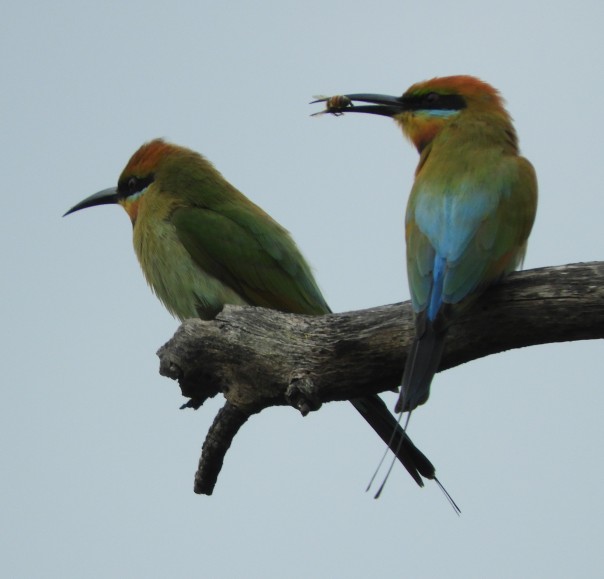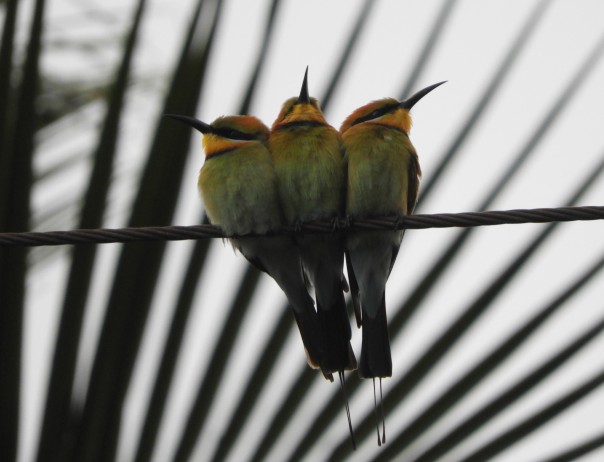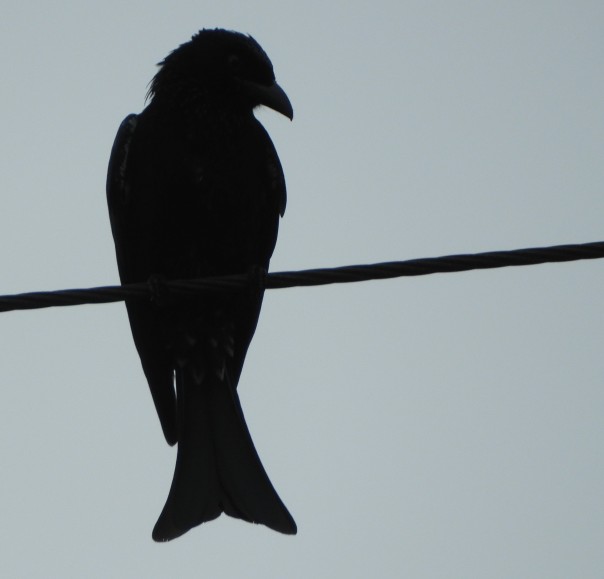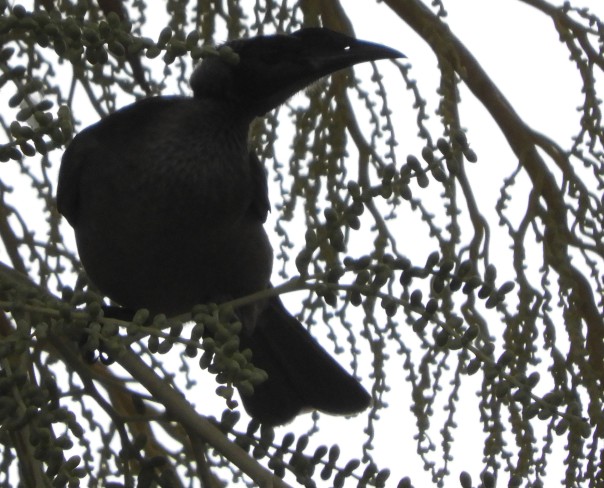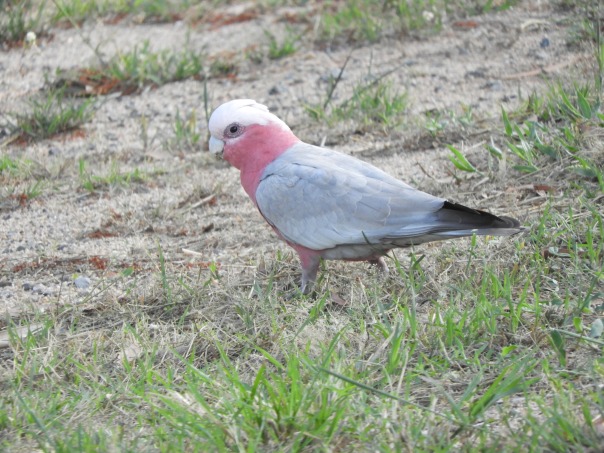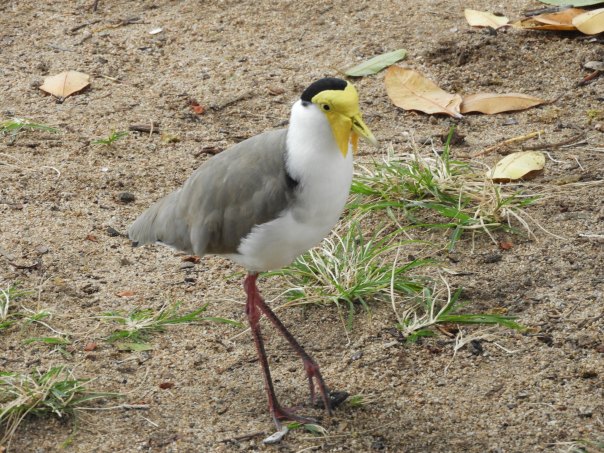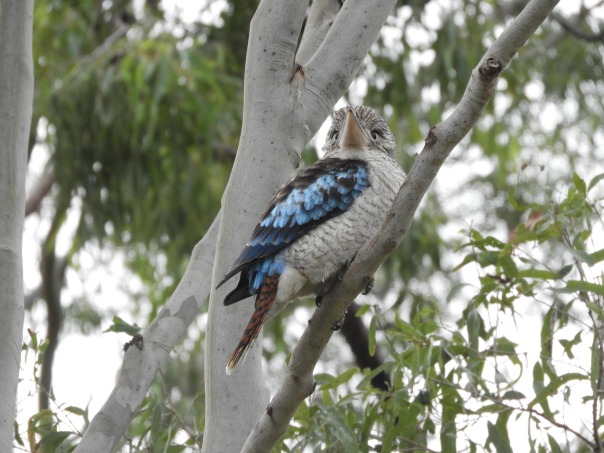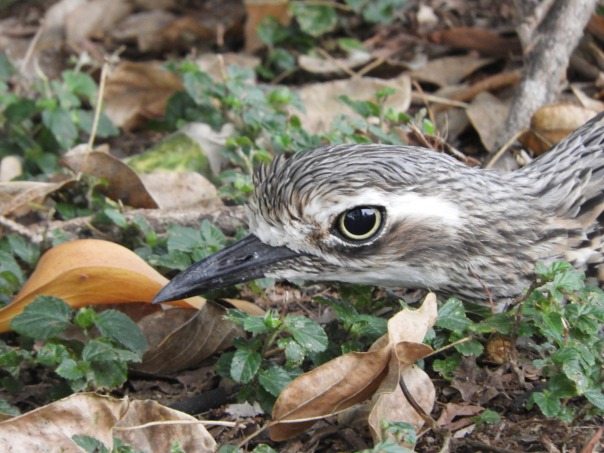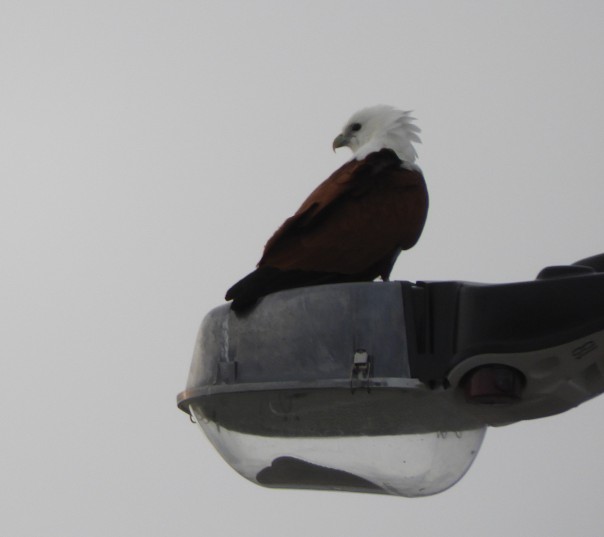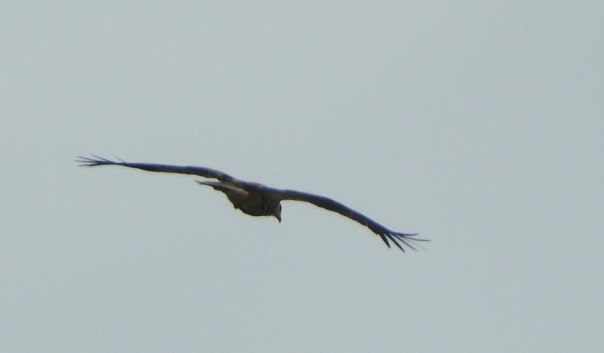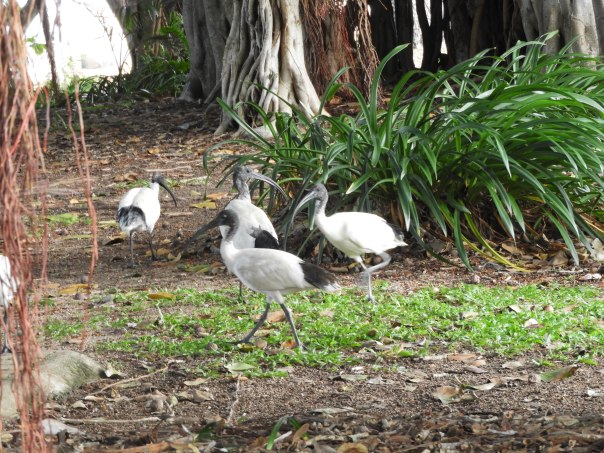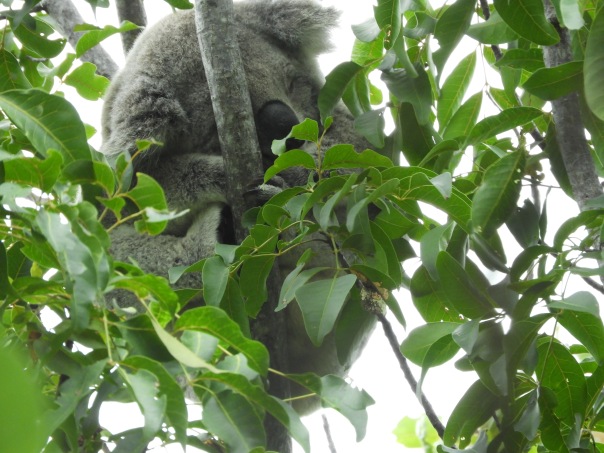Category Archives: Dove
Peaceful Dove calling
In Merriwa, NSW, the call of a Peaceful Dove sounds out above the early morning bird chorus:
Peaceful Doves are small doves, coloured shades of grey with an apricot tinge, and a blue ring of bare skin around the eye.
Common name: Peaceful Dove
Scientific name: Geopelia placida
Approximate length: 20-24 cm
Date spotted: 13 September 2025 (spring)
Location: Merriwa, New South Wales, Australia: 32°23’36.0″S 150°41’07.8″E
Rose-crowned Fruit Dove near Sydney
My first sighting of a Rose-crowned Fruit Dove in the wild!
A few days ago, I saw a social media post saying that people were seeing a Rose-crowned Fruit Dove in Manly, just north of Sydney. I was surprised, because these birds are more common further north. I verified the sightings on eBird, then went to see if I could find the bird.
My first few trips were fruitless, though there was a lot of fruit around, in the form of Blueberry Ash berries! When I later spotted a Rose-crowned Fruit Dove, it was in the midst of these blue berries.
Rose-crowned Fruit Doves are amazingly colourful — not what first comes to my mind when I think of doves. They get their name from the pink patch just above their beaks. The back and wings are a striking emerald green, and the front is a soft grey on the chest, moving to bright yellow and orange on the belly, then merging into a more lime-coloured green under the tail:

A frontal view shows the chest and belly, as well as the good strong legs and feet:

The dove had some competition for the berries from other birds. In particular, a group of figbirds moved in and started a bit of a squabble. The next photo shows the Rose-crowned Fruit Dove at top right and a figbird at bottom left. The photo gives a good view of the dove’s emerald green back:
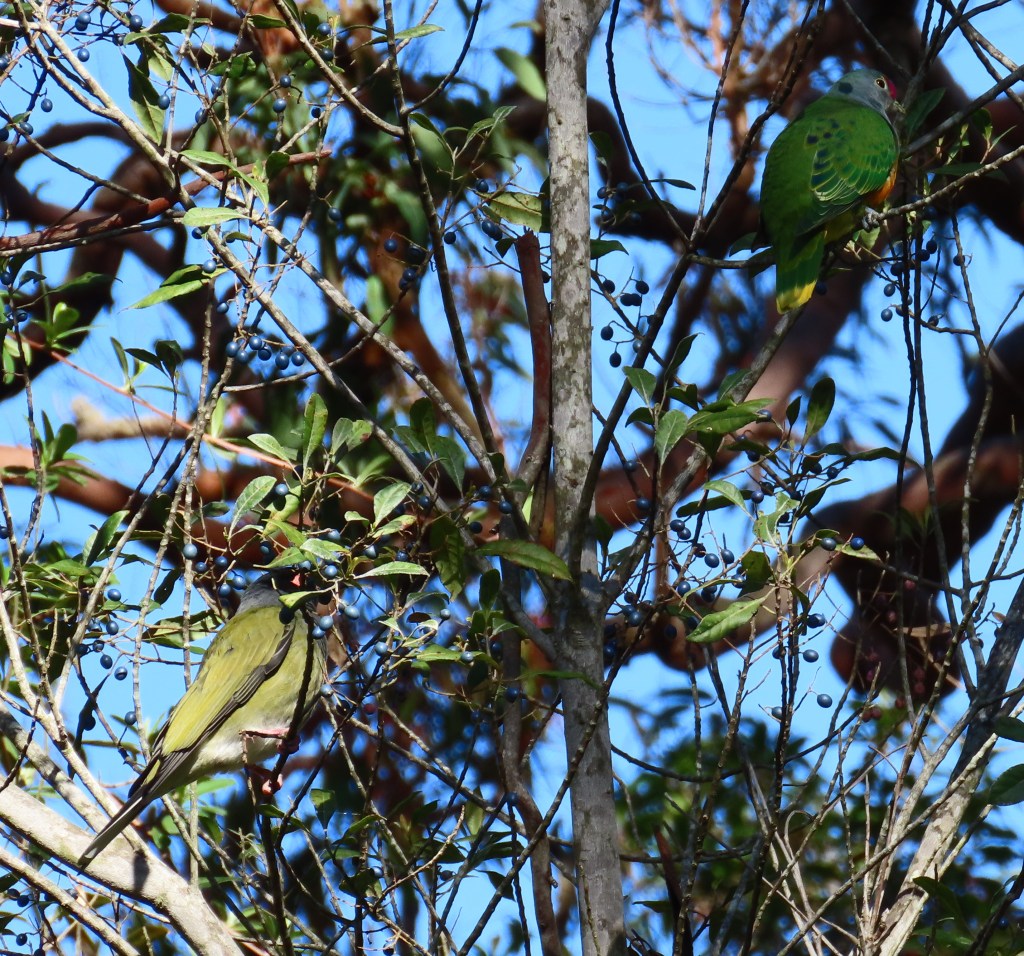
Here’s a short video of the dove moving around:
Common name: Rose-crowned Fruit Dove
Scientific name: Ptilinopus regina
Approximate length: 22-24 cm
Date spotted: 7 September 2025 (spring)
Location: Manly North Head, Sydney Harbour National Park, New South Wales, Australia: 33°48’35.7″S 151°17’32.8″E
Evidently Rose-crowned Fruit Doves migrate to follow the fruit. They’ve been spotted breeding in this area too, and other people have seen a couple of juveniles in the same area recently.
One of the nicest experiences about this sighting was the bird watchers that I met. On the day when I actually saw Rose-crowned Fruit Dove, there was a group of people all pointing their cameras in the same direction. I was immediately fairly sure the bird was there, and indeed it was. People were generous in pointing out the bird and making sure I had a good spot to get my photos:

Brown pigeon in Sydney but not a Brown Cuckoo-Dove?
This lovely brown pigeon perched on a post at Pyrmont in Sydney. Does anyone know what type of pigeon it is?

Here’s a closeup of the bird:
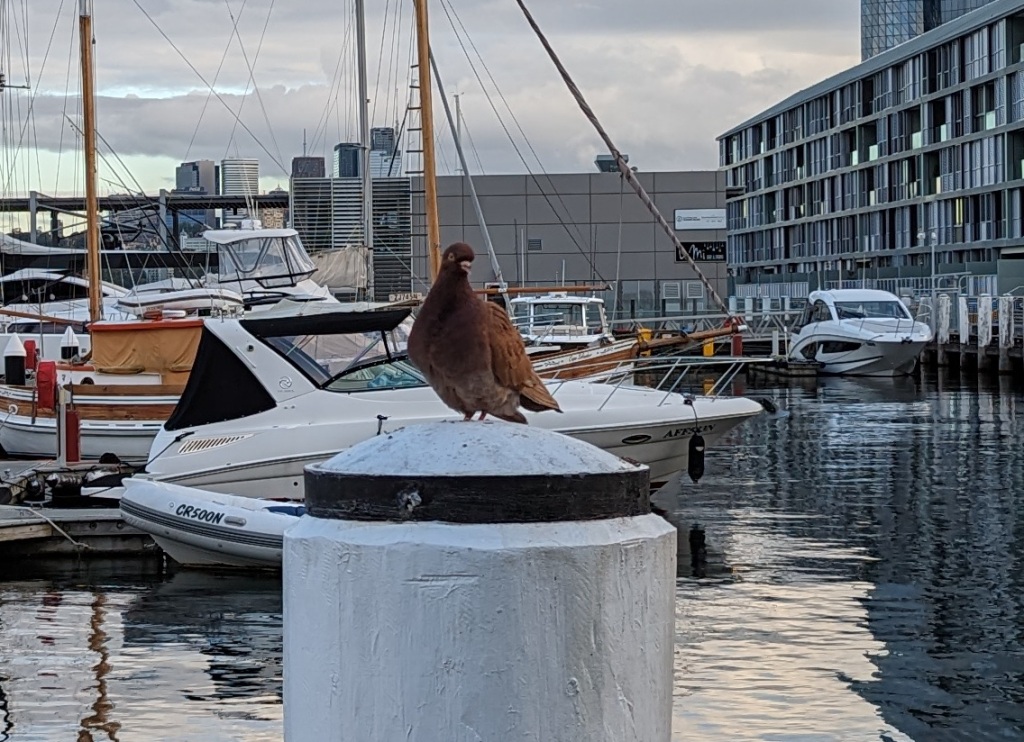
It doesn’t look like a Brown Cuckoo-Dove (Macropygia amboinensis) — the colouring isn’t quite right. This bird has a light-coloured beak and a light ring around its eye. Its chest plumage is as dark as the wings. Also, I don’t think its tail is long enough for a cuckoo-dove.
This picture shows the bird from a different angle, so that you can see its back, wings and tail:

Here’s a picture of the bird flying off:
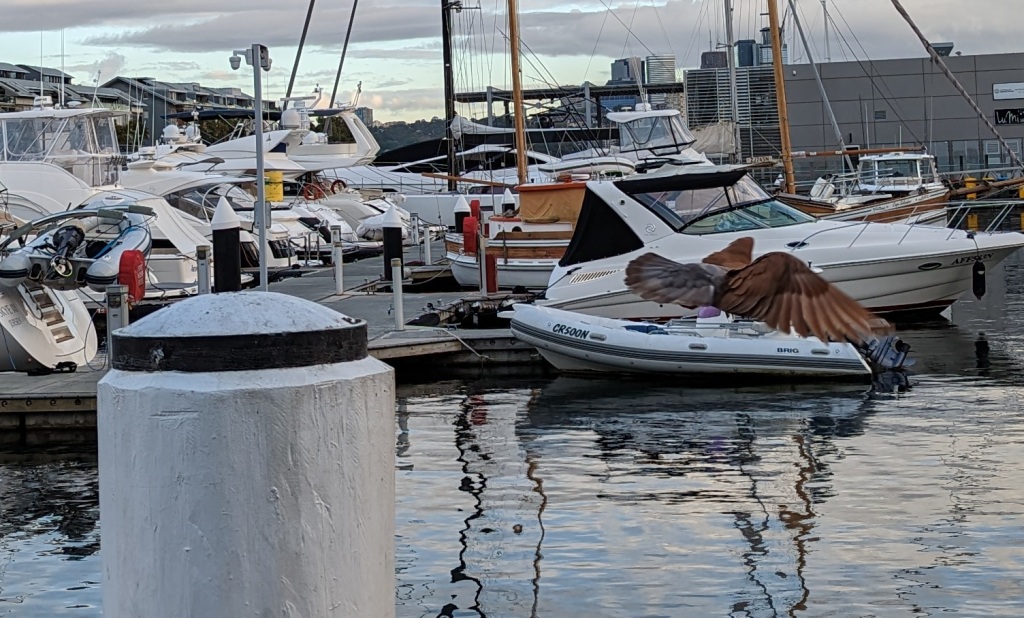
Common name: Pigeon
Scientific name: Unknown
Date spotted: 21 December 2022 (summer)
Location: Pyrmont, Sydney, New South Wales, Australia: 33°52’03.7″S 151°11’48.8″E
Common Bronzewing pigeon in Blue Mountains
This weekend I spent a day in the region of Kurrajong in the Blue Mountains area west of Sydney. On an early morning walk, I came across this large, colourful pigeon:

It’s a Common Bronzewing. I’d heard their calls from all round me in the bush: a deep, booming coo that sounds like something from Jurassic Park rather than from a pigeon!
Common name: Common Bronzewing
Scientific name: Phaps chalcoptera
Approximate length: 30-36cm
Date spotted: 31 October 2021 (spring)
Location: Grose Wold, New South Wales: 33°36’41.7″S 150°39’50.0″E
Crested Pigeon doing what pigeons do
This pretty little Crested Pigeon isn’t doing much. It’s pecking at food, as pigeons do. But I found the colouring of the scene attractive:
Common name: Crested Pigeon
Scientific name: Ocyphaps lophotes
Approximate length: 31-35 cm
Date spotted: 26 December 2019 (summer)
Location: Long Reef Headland, Collaroy, New South Wales, Australia: 33°44’37.0″S 151°18’20.2″E
Hybrid Spotted Turtle-Dove with Crested Pigeon?
Today I spotted a couple of interlopers in an area that’s the regular hangout for a group of Crested Pigeons. One of the interlopers looks like a regular Spotted Turtle-Dove. Here’s a Crested Pigeon on the left and the interloper on the right:
But nearby, on the same wire, is this rather interesting individual:
The bird looks like a Spotted Turtle-Dove but has a bit of feathery decoration on its head. Could it be a cross-breeding of a Spotted Turtle-Dove with a Crested Pigeon? Or is it just a Spotted Turtle-Dove having a bad hair day?
Here’s another pic of the same Crested Pigeon as in the first photo:
Crested Pigeons are native to Australia. When they take off, you hear the distinctive whistling noise from their wings that is characteristic of many pigeon types. When I first saw these birds, I thought how typical it is that even the common pigeons in Australia are different from those I’ve seen in other part of the world.
The group of birds later moved down to forage on the ground. Here’s one of the Crested Pigeons:
There was only one bird that looked like a Spotted Turtle-Dove with a vestigial crest. Here’s another pic of the same bird:
Spotted Turtle-Doves are not native to Australia. They were introduced in the late 1800s, and are seen as a pest in some regions of the country.
Pigeon or dove? The names “Crested Pigeon” and “Spotted Turtle-Dove” led me to wondering, not for the first time, what the difference is between a pigeon and a dove. I’ve asked various people over the years. Some say doves are white whereas pigeons are not. Other say that doves are smaller than pigeons. According to much of the internet, the two terms are interchangeable.
Here’s another view of the same bird with the miniscule crest (or perhaps it’s just a feather expressing its individual identity):
A wink, almost as if the bird knows that it’s presented me with a puzzle:
Spotted Turtle-Dove | Scientific name: Streptopelia chinensis | Approximate length: 30-32 cm
Crested Pigeon | Scientific name: Ocyphaps lophotes | Approximate length: 31-35 cm
Date spotted: 5 July 2019 (Winter)
Location: Allambie Heights, New South Wales, Australia
Birds on Magnetic Island
Last week I spent three days on Magnetic Island in North Queensland. Magnetic Island is a small island just offshore from Townsville. That’s approximately 2,000 km north of Sydney. The ferry ride from the mainland takes twenty minutes on the foot-passengers ferry, or forty minutes on the vehicle ferry. The island is a relaxing, lovely place to be.
Although I was on Magnetic Island for only a short while (two full days plus one evening and one morning) I encountered quite a few birds. Here are 16 of them, in rough order of size from small to large.
Yellow-bellied Sunbird
Scientific name: Nectarinia jugularis | Approximate length: 10-12 cm
This is a female Yellow-bellied Sunbird, spotted at Picnic Bay on Magnetic Island:
The beak of the Yellow-bellied Sunbird is long and curved, adapted for feeding from flowers:
White-breasted Woodswallow
Scientific name: Artamus leucorynchus | Approximate length: 16-18 cm
Three White-breasted Woodswallows clumping together. It was a chilly morning (well, chilly for the tropics, that is) so I guess they were sharing body heat:
Peaceful Dove
Scientific name: Geopelia placida (striata) | Approximate length: 20-24 cm
The Peaceful Dove is a small dove with an apricot tinge to its feathers. It has a soft, pleasant call as you can hear towards the end of this video:
Here’s a still shot of the same bird:
Rainbow Bee-eater
Scientific name: Merops ornatus | Approximate length: 23-27 cm
Given the name of this bird, I was particularly excited to snap one actually eating a bee!
Here’s a bird in the act of catching a bug:
This trio of bee-eaters clumped cosily in the chilly air of the early morning. Even a tropical island can feel cold to inhabitants used to the warmer summer weather:
Rainbow Lorikeet
Scientific name: Trichoglossus haematodus | Approximate length: 26-31 cm
These colourful parrots are extremely noisy, especially when you have a tree full of them:
Spangled Drongo
Scientific name: Dicrurus bracteatus | Approximate length: 28-32 cm
Drongo – what a cute name! Yet in Australia if someone calls you a “Drongo” you want to look closely at them, as it’s a bit of an insult. It means they think you’re not all that bright.
This is a female Spangled Drongo, I think, as its eyes are brown whereas the male has red eyes:
It’s easy to confuse these birds with crows and ravens. In fact, I heard Australian Ravens calling on the island, but didn’t get a photo of one.
The next photo is a pretty much a silhouette, but it shows off the Spangled Drongo’s forked tail:
Helmeted Friarbird
Scientific name: Philemon buceroides | Approximate length: 32-37 cm
This Helmeted Friarbird sat quietly on a branch listening to the birds all round. When it tilts its head you can see the odd-shaped knob on top of its beak:
Here’s another peering through the foliage:
Galah
Scientific name: Cacatua roseicapilla | Approximate length: 38 cm
Galahs are pretty pink and grey parrots. Australians sometimes call someone a “silly galah”, which I think is a slightly more affectionate term than “drongo”! I’ve seen Galahs in the Sydney area as well as up here on Magnetic Island. This one was picking up seeds on the ground. There’s another Galah nearby, which you can hear chirping to its mate towards the end of the video:
Here’s a still photo:
Masked Lapwing, also called a Spur-winged Plover
Scientific name: Vanellus miles | Approximate length: 35-39 cm
Masked Lapwings are strange-looking birds with yellow faces that seem to have been stuck on as an after-thought.
Their alternative name of “spur-winged” is apt, because they have hooks on their wings, one on each, which they use as weapons, stretching the wings then dragging back to wound their enemy.
In the next photo, the bird at the back is a juvenile. Its legs are brown instead of the red of the adult, and its mask has not yet fully developed:
Blue-winged Kookaburra
Scientific name: Dacelo leachii | Approximate length: 38-42 cm
The kookaburras up north are different from the Laughing Kookaburras that we see around Sydney. Blue-winged Kookaburras look leaner and meaner. They have bright blue markings on their wings, and they lack the wide dark strip that marks the eyes of Laughing Kookaburras. Here’s a Blue-winged Kookaburra on Magnetic Island:
They do look just as silly as our local birds when they gaze at us straight on:
The cackling laughter of the Blue-winged Kookaburras seemed harsher and higher pitched to me. I didn’t manage to record any of the noise. This video shows a bird sitting on the top of a high post, swaying backwards and forwards as they do to retain their balance:
Silver Gull
Scientific name: Larus novaehollandiae (also called Chroicocephalus novaehollandiae) | Approximate length: 38-42 cm
A Silver Gull warning off another Silver Gull:
Sulphur-crested Cockatoo
Scientific name: Cacatua galerita | Approximate length: 45-50 cm
Sulphur-crested Cockatoos abounded on the island. Here are a couple peeking out from the branches of a huge palm tree:
A closer look at one of the birds:
Bush Stone-curlew
Scientific name: Burhinus grallarius | Approximate length: 55-60 cm
If you’re lucky enough to be on Magnetic Island at night, you’ll hear an eerie wailing in the lonely hours. Report has it that the local police regularly receive calls from visitors to report screaming in the night. Don’t be alarmed. It’s just the Stone-curlews.
Bush Stone-curlews have amazing camouflage, even during the day. Spot the bird if you can (click on the image to zoom in):
Here’s a close-up picture of the same bird:
Bush Stone-curlews have lovely big eyes:
Bush Stone-curlews tend to move slowly and timidly, then make a quick dash. Here’s one moving slowly along a fence:
Brahminy Kite
Scientific name: Haliastur indus | Approximate length: 55-60 cm; wing span 1.2-1.3 m
I watched this Brahminy Kite for a while early one morning. The bird was perched on top of a very high post above a stone jetty. I had to use full zoom on my camera, and the resolution isn’t wonderful. Still, the photo gives a good idea of the bird’s appearance:
These kites are common around the northern shores of Australia. At first I confused the bird with an eagle, but then I noticed the striking white chest and head feathers, and the rich chestnut colour on the back and wings, which are characteristic of Brahminy Kites. Here’s a photo of the bird flying – again, fuzzy, but you get the idea of the shape and colour:
Whistling Kite
Scientific name: Haliastur sphenurus | Approximate length: 50-60 cm; wing span 1.2-1.5 m
This bird was high in the sky, circling above the ocean and the hills:
Here’s the same bird from another angle:
Australian White Ibis
Scientific name: Threskiornis molucca | Approximate length: 65-75 cm
These ibises are affectionately known as “bin chickens” because in cities they spend a lot of time raiding dustbins. This group was prowling around the beach area, no doubt in search of scraps from the nearby restaurants:
Koala
Not a bird! But I can’t leave a post about Magnetic Island without showing a picture of a Koala. The island has the largest population of wild koalas in Australia:
I hope you’ve enjoyed my post about the lovely Magnetic Island!





